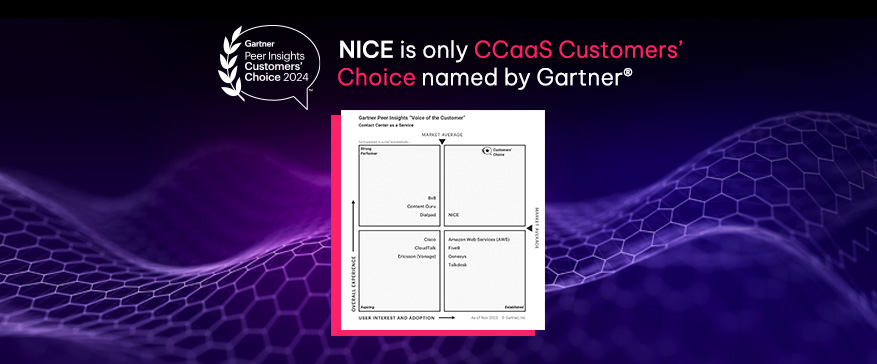The innovator's guide to the digital-first contact center
Problem Snapshot
- This is a time when an increase in inbound call volume is at a time when agent staffing may not be up to par.
- For companies who also handle outbound engagement, this creates an even greater challenge as blended agents may be held up by the increase in inbound calls.
- Customers have been impacted with longer hold times that lead to decreased satisfaction.
The Solution
Any well-designed IVR system will be optimized to eliminate waiting on hold — by all accounts the most egregious offense to the customer experience — and either present self-service options or define a time when agents will be available to offer their services.By interacting with menu options in your IVR, customers are presented with the quickest possible route to resolving their issue. You can configure any number of different support SMS messages to be triggered with the click of button, or use the standard instructional audio snippets to prompt them to self-serve within the IVR or be taken out of the call queue entirely to wait for a callback. Because a traditional IVR lets you configure instructional audio to play in the call flow using automated voice, at any stage where the customer requires choice you can prompt them to receive a text message and continue the conversation mobily.Adding text message triggers to your IVR menu is the quickest and most cost-effective way to provide mobile service and minimize the pressure on voice agent resources within the contact center. For example, the large numbers of calls for routine interactions like account balance checks, payments, card replacements, password resets, or suspicious activity could be resolved by triggering an SMS message that includes step-by-step instructions or a link to your knowledge base with more information on how to self-serve.Understanding IVR and SMS
IVR stands for interactive voice response. It’s the automated voice menu most customers are familiar with reaching when they call a company’s support phone number. Instead of merely pressing buttons, IVR allows customers to interact with the menu using speech. While very different, some companies are using SMS as an IVR alternative.IVR helps both agents and customers by:- Gathering more information about the reason for the call, which helps route it to the most appropriate resource
- Offering self-service options, which enables fast resolutions and reduces agent workloads
- Providing basic information and deflecting inbound call volume during peak call hours
- Gives customers a convenient way to communicate with a company
- Can automate the process of disseminating information
- Helps route customers to the best available resource while deflecting calls away from live agents
Give customers what they want
People don’t enjoy repeating themselves, and they dislike it even more when it’s a robot asking them to do it.As anyone who has attempted to convey a credit card number while in an IVR will tell you, they aren’t greeeeaaat at interpreting alphanumeric inputs. And the moment doing so fails, the customer is taken to an agent who then asks them to repeat said number again, adding yet another layer of inefficiency to the transaction. In many routine cases the IVR serves mainly as a routing function, and this is where adding in SMS to your IVR menu can be extremely effective.Say, for instance, a customer calls in to change their address. With SMS enabled, the IVR text message can provide the caller an option to receive a text prompting them to input the requisite contact details as a reply. Once those details are provided and sent back via text, the IVR can continue through the rest of the flow or forward to live assistance if such a measure is needed. Another option is to send a text with a URL that the customer can press and enter then the relevant information.Regardless, this interaction was just reduced by minutes, and your customer spared an immeasurable amount of frustration. Moreover, this is something that comes completely naturally to us! Texting is something we do everyday.The best proof of this pudding is the fact that customers have already told us to text them:- 78% of people say text messaging is the fastest way for companies to reach them
- 98% of SMS alerts are read by customers
- SMS has 5X the open rate for SMS as compared to the open rate of emails
SMS can increase the potential and efficiency of remote agents.
On the flip side, from an operational perspective, digital messaging channels afford newly remote contact centers more control over their environment because they mitigate background noise without compromising interaction quality.Further, supplementing an IVR to SMS interaction with digital channels like SMS sets up a win-win situation for your business and your customer insofar as the customer gets to complete a transaction fully with minimal hassle and your contact center gets to convert an expensive, agent-assisted interaction into a self-guided experience driven by the customer which usually means lots of cost (and time) savings. And, if that wasn’t enough:- Messaging agents do not require as much bandwidth as voice agents, so you can create a wider opportunity for agents to work from home.
- Messaging shifts agent service capacity from a 1-to-1 conversation to a many-to-one conversation as agents can handle numerous asynchronous conversations at once.
- Messaging also allows agents to ramp up quickly for SMS intraday peaks. Like voice campaigns, inbound SMS volume can be directly tied to outreach efforts.









